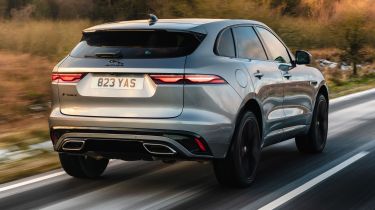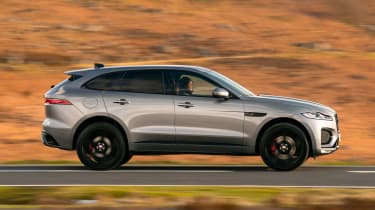Jaguar F-Pace review - Engines, performance and drive
Few SUVs are as fun or capable as the Jaguar F-Pace, and it's nearly as sweet to drive as the Porsche Macan

Jaguar could have turned to sister brand Land Rover for help with its first SUV, but instead it developed its own platform for the F-Pace. The F-Pace is based on Jaguar’s iQ-AL platform that also partly underpins the XE and XF saloons. This helps the F-Pace feel as sporty to drive as it looks. That’s because it shares the saloon’s suspension set-up, which uses double wishbones at the front and a multi-link rear axle that’s set-up to deliver engaging handling.
Where the Jaguar has a real edge over its rivals is the way it drives. With lots of grip and good body control, the F-Pace is fun to drive; it’s hard to believe a high-riding SUV can handle as well as this. It remains composed even on bumpy roads, and comfort doesn’t take too much of a hit to deliver those fun dynamics. The eight-speed auto transmission is smooth enough when left to work itself, although we found switching to the manual shift paddles produced more sluggish gear changes.
There’s very little road and wind noise, plus the ride is nearly as supple and well controlled as the Mercedes GLC with its air suspension. Bigger undulations can upset the SUV’s balance, but you’ll never notice jolts in the cabin – even on the larger alloy wheels.
Used - available now

2022 Fiat
500
22,532 milesManualPetrol1.0L
Cash £9,549
2023 Honda
Jazz
24,192 milesAutomaticPetrol1.5L
Cash £14,999
2022 Vauxhall
Corsa
30,379 milesManualPetrol1.2L
Cash £11,549
2022 MINI
5-Door Hatch
32,498 milesAutomaticPetrol1.5L
Cash £15,049The F-Pace is surprisingly capable off-road, too. While Jag is leaving the proper tough stuff to Land Rover, the F-Pace is admirably efficient when faced with muddy ruts or a grassy field. The four-wheel-drive system does sometimes scrabble for grip, but that's more down to the road-biased tyres, and on the whole it gives you confidence to push the car some way off the beaten track.
In normal driving, the 4WD system features a clever system that sends more power to the rear wheels to give a purer feel, but switches extra drive to the front wheels when it senses a more even split of traction is required.
Jaguar also offers the optional Dynamic Pack, which costs around £2,900 and adds adaptive dampers. These are continuously adjustable and constantly alter to the road conditions, unlike most rivals which have pre-set modes. It’s a pricey package, but is worth choosing because there’s a better mix of comfort and agility.
0-62mph acceleration and top speed
Jaguar F-Pace buyers get a broad choice of engines. The entry-level, four-cylinder D200 diesel produces 201bhp and 430Nm of torque; enough to propel the mid-size premium SUV from 0-62mph in 8.2 seconds. The six-cylinder D300 pumps out 296bhp and completes the same benchmark sprint in 6.4 seconds.
The petrol-powered cars inevitably bring quicker acceleration, and even the least powerful 246bhp P250 posts a 0-62mph time of 7.3 seconds. The 395bhp P400 six-cylinder in the 400 Sport-spec models takes 5.4 seconds to reach 62mph from a standstill, while the 398bhp P400e plug-in hybrid only needs 5.3 seconds to hit 62mph.
The fire-breathing F-Pace SVR is frankly ridiculous and will put some supercars to shame in a straight line. Its supercharged V8 pumps 542bhp and 700Nm of torque that can propel the two-tonne SUV from a standstill to 62mph in just four seconds, before moving on to a top speed of 178mph.









